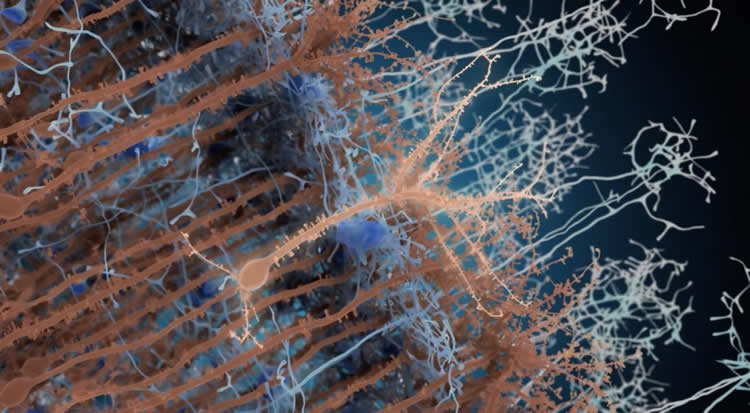Summary: Researchers observe how adult neurons form and evolve in the olfactory bulb of mice.
Source: Institut Pasteur.
Scientists from the Institut Pasteur and the CNRS were able to make real-time observations over a period of several months that reveal how new adult-born neurons are formed and evolve in the olfactory bulb of mice. They made the surprising discovery that there is constant structural plasticity in the connections established by these new neurons with the circuits into which they are recruited. The scientists showed that this neuronal dynamism can enable optimal processing of sensory information by the olfactory bulb. These findings are to be published in the journal Neuron on June 30, 2016.
Although most neurons are generated during embryogenesis, some regions of the brain, such as the olfactory bulb in rodents and the hippocampus in humans, are capable of constantly regenerating their neurons in adulthood. Scientists first conclusively discovered these new adult neurons around 15 years ago, but their function remained a mystery, mainly because they are inaccessible in living animals.
In an article published in the journal Neuron, scientists from a unit at the Institut Pasteur directed by CNRS scientist Pierre-Marie Lledo provide further evidence of the highly dynamic nature of the changes observed at the neuronal level in adult brains. The scientists spent several months observing the development of neurons formed in adulthood in the olfactory bulbs of mice. This gave them the unique opportunity to see the formation, stabilization and elimination of connections between neurons in real time.
They revealed that in the olfactory bulb, where new neurons are continuously formed, the connections between these new neurons and neighboring cells are significantly rearranged throughout their lifetime. All these neurons are constantly reorganizing the billions of “synaptic” contacts they establish among themselves. The scientists were surprised by this observation. “We expected to see the synapses gradually stabilizing, as happens during brain development. But astonishingly, these synapses proved to be highly dynamic throughout the life of the new neurons. Also, these dynamics were reflected in the principal neurons, their primary synaptic partner,” explained first author, Kurt Sailor, from the Institut Pasteur.
To observe the ongoing formation of neuronal circuits, the scientists marked the new neurons with a green fluorescent protein (GFP), to allow imaging of the dynamic changes with microscopy. These experiments were carried out over a period of several months to follow the entire life cycle of the new neurons. In the first three weeks of their life, these new neurons extended their cellular projections, known as dendrites, to form several ramifications, which subsequently became very stable. They next observed the neuronal spines, the structure where synapses form, and demonstrated that 20% of the synapses between new and pre-existing neurons were changed on a daily basis – a phenomenon that was also observed in their synaptic partners, the principal olfactory bulb neurons. Using computer-based models, the authors showed that these dynamics enabled the synaptic network to adjust efficiently and reliably to ongoing sensory changes in the environment.

“Our findings suggest that the plasticity of this constantly regenerating region of the brain occurs with continuous physical formation and elimination of synaptic connections. This structural plasticity reveals a unique dynamic mechanism that is vital for the regeneration and integration of new neurons within the adult brain circuit,” concluded the scientists. More generally, this study suggests a universal plasticity mechanism in brain regions that are closely associated with memory and learning.
Funding: This research was supported by the Institut Pasteur and the CNRS and was funded by AG2R-La Mondiale, the French National Research Agency, the “Revive” LabEx and the “Biopsy” LabEx.
Source: Myriam Rebeyrotte – Institut Pasteur
Image Source: This NeuroscienceNews.com image is credited to Institut Pasteur/PM Lledo.
Original Research: Abstract for “Persistent Structural Plasticity Optimizes Sensory Information Processing in the Olfactory Bulb” by Kurt A. Sailor, Matthew T. Valley, Martin T. Wiechert, Hermann Riecke, Gerald J. Sun, Wayne Adams, James C. Dennis, Shirin Sharafi, Guo-li Ming, Hongjun Song, and Pierre-Marie Lledo in Neuron. Published online June 30 2016 doi:10.1016/j.neuron.2016.06.004
[cbtabs][cbtab title=”MLA”]Institut Pasteur. “The Relentless Dynamism of the Adult Brain.” NeuroscienceNews. NeuroscienceNews, 1 July 2016.
<https://neurosciencenews.com/adult-neurogenesis-neuroscience-4611/>.[/cbtab][cbtab title=”APA”]Institut Pasteur. (2016, July 1). The Relentless Dynamism of the Adult Brain. NeuroscienceNew. Retrieved July 1, 2016 from https://neurosciencenews.com/adult-neurogenesis-neuroscience-4611/[/cbtab][cbtab title=”Chicago”]Institut Pasteur. “The Relentless Dynamism of the Adult Brain.” https://neurosciencenews.com/adult-neurogenesis-neuroscience-4611/ (accessed July 1, 2016).[/cbtab][/cbtabs]
Abstract
Persistent Structural Plasticity Optimizes Sensory Information Processing in the Olfactory Bulb
Highlights
•All granule cells in the olfactory bulb have highly dynamic spines throughout life
•Mitral/tufted cell gephyrin puncta have matching dynamics
•Computational modeling shows advantages of this robust structural plasticity
•Structural plasticity may be the primary form of plasticity at this synapse
Summary
In the mammalian brain, the anatomical structure of neural circuits changes little during adulthood. As a result, adult learning and memory are thought to result from specific changes in synaptic strength. A possible exception is the olfactory bulb (OB), where activity guides interneuron turnover throughout adulthood. These adult-born granule cell (GC) interneurons form new GABAergic synapses that have little synaptic strength plasticity. In the face of persistent neuronal and synaptic turnover, how does the OB balance flexibility, as is required for adapting to changing sensory environments, with perceptual stability? Here we show that high dendritic spine turnover is a universal feature of GCs, regardless of their developmental origin and age. We find matching dynamics among postsynaptic sites on the principal neurons receiving the new synaptic inputs. We further demonstrate in silico that this coordinated structural plasticity is consistent with stable, yet flexible, decorrelated sensory representations. Together, our study reveals that persistent, coordinated synaptic structural plasticity between interneurons and principal neurons is a major mode of functional plasticity in the OB.
“Persistent Structural Plasticity Optimizes Sensory Information Processing in the Olfactory Bulb” by Kurt A. Sailor, Matthew T. Valley, Martin T. Wiechert, Hermann Riecke, Gerald J. Sun, Wayne Adams, James C. Dennis, Shirin Sharafi, Guo-li Ming, Hongjun Song, and Pierre-Marie Lledo in Neuron. Published online June 30 2016 doi:10.1016/j.neuron.2016.06.004






